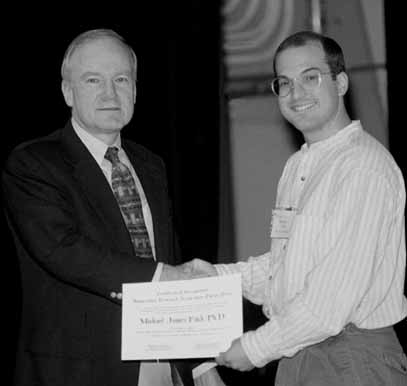 |
|
Forum on the Future: by Mike Perricone
With a 26-kilometer Linear Collider, a straight line surely represents the shortest distance to the future of the U.S. High-Energy Physics community.
Or maybe not.
A 233-kilometer-circumference Very Large Hadron Collider is the one proposed machine pointing with certainty to a major high-energy physics discovery in the century's second decade and beyond.
Or maybe not.
There is no time to lose in deciding between these two machines.
Or is there?
The Users' Annual Meeting at Fermilab always offers a platform for the exchange of data and ideas, but the gathering on June 11-12 took on added significance as a forum on the future. The DOE/NSF High-Energy Physics Advisory Panel's Subpanel on Long Range Planning For U.S. High-Energy Physics requested that the meeting focus on proposals for the next 20 years. The panel, co-chaired by Jonathan Bagger of Johns Hopkins University and Barry Barish of California Institute of Technology, is holding a series of advisory meetings across the country. Included are three "Town Meetings" at Brookhaven, SLAC and Fermilab where researchers are free to create their own agenda for presentations and proposals.
And so the two-day gathering of scientists from the lab's world-wide array of 90 research partner institutions continued the debate between LC and VLHC proponentsˇwith other speakers addressing a new proton driver for Fermilab, continued consideration of a muon storage ring and neutrino factory, the expanding confluence of particle physics, astrophysics and cosmology, the importance of stressing Collider Run II of the Tevatron, and reminders that "small science" is critical for students to conduct their research while the big machines grab the headlines.
Two lab directors, Michael Witherell of Fermilab and Jonathan Dorfan of Stanford Linear Accelerator Center, supported the concept of a first-stage 500 GeV electron-positron Linear Collider as the next-generation machine, to be built in the U.S. by an international collaboration. Witherell further specified a location at or near Fermilab, focusing on its strong base of expert personnel and existing infrastructure.
Witherell described research and development on VLHC technology as an important component of a balanced physics program over the next decade, while estimating a start for VLHC construction around 2012. But building the Linear Collider was essential for this decade, to begin operation in the next. Witherell described the physics case for the 500 GeV Linear Collider as "very strong," in answering important questions of electroweak symmetry breaking.
Speaking by video presentation, Dorfan said a linear collider would "unravel the origins of electroweak symmetry breaking." The machine, he said, was "an urgent need" as a companion for LHC research, and SLAC "commits itself to a central role" in the linear collider's construction and operation. But he also indicated that a decisionˇand an appearance of decisivenessˇwould convey a sense of focus with symbolic and political importance.
"Those of us who spend a lot of time in Washington are perceived as not having a clear plan for high-energy physics, and that hurts us," Dorfan said. "U.S. high-energy physics has flourished by making bold steps. The field has never required guaranteed payoffs, but the payoffs have been spectacular. This is not the time to be conservative. Conservative planning is a recipe for mediocrity."
During the Town Meeting, a study group offered a detailed, multifaceted proposal for the Very Large Hadron Collider as successor to the Large Hadron Collider being built at CERN, the European Particle Physics Laboratory.
Peter Limon, Head of Fermilab's Technical Division, asserted that "the big discoveries are produced by hadron colliders at the energy frontier, and a hadron collider is the only sure way to reach a major discovery." He envisioned VLHC as "part of a world-wide plan that includes a lepton [linear] collider." He proposed the big circular tunnel housing a first-stage 40 TeV collider, followed by an upgrade to 200 TeVˇmuch as the Large Electron-Positron collider is now being supplanted by the LHC at CERN.
And in a time of budget constraints, Louisiana State graduate student Morgan Wascko made a cogent case for cosmic ray experiments. Not only do cosmic rays represent "the true energy frontier," he said, but "the beam is always onˇand it's free." He added another telling point: "My Mom is always more interested in cosmology results than in accelerator results."
The wry conclusion actually touched on a central issue: public support is crucial to the future of particle physics. No doubt about it.
On the web:
|
| last modified 7/9/2001 by C. Hebert email Fermilab |
FRLsDFx9eyfrPXgV

 But the big machines aren't the only discovery-producers. Columbia University graduate student Bonnie Fleming, a neutrino researcher, reminded users (and the HEPAP members) that "small experiments can make a big splash." She specifically referred to DONUT, the Fermilab experiment that last year reported the first direct observation of the tau neutrino, completing the picture of the Standard Model.
But the big machines aren't the only discovery-producers. Columbia University graduate student Bonnie Fleming, a neutrino researcher, reminded users (and the HEPAP members) that "small experiments can make a big splash." She specifically referred to DONUT, the Fermilab experiment that last year reported the first direct observation of the tau neutrino, completing the picture of the Standard Model.